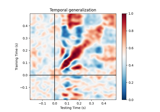mne.decoding.FilterEstimator¶
- class mne.decoding.FilterEstimator(info, l_freq, h_freq, picks=None, filter_length='auto', l_trans_bandwidth='auto', h_trans_bandwidth='auto', n_jobs=1, method='fir', iir_params=None, fir_design='firwin', verbose=None)[source]¶
Estimator to filter RtEpochs.
Applies a zero-phase low-pass, high-pass, band-pass, or band-stop filter to the channels selected by “picks”.
l_freq and h_freq are the frequencies below which and above which, respectively, to filter out of the data. Thus the uses are:
l_freq < h_freq: band-pass filter
l_freq > h_freq: band-stop filter
l_freq is not None, h_freq is None: low-pass filter
l_freq is None, h_freq is not None: high-pass filter
If n_jobs > 1, more memory is required as “len(picks) * n_times” additional time points need to be temporarily stored in memory.
- Parameters
- infoinstance of
Info Measurement info.
- l_freq
float|None For FIR filters, the lower pass-band edge; for IIR filters, the lower cutoff frequency. If None the data are only low-passed.
- h_freq
float|None For FIR filters, the upper pass-band edge; for IIR filters, the upper cutoff frequency. If None the data are only high-passed.
- picks
str|list|slice|None Channels to include. Slices and lists of integers will be interpreted as channel indices. In lists, channel type strings (e.g.,
['meg', 'eeg']) will pick channels of those types, channel name strings (e.g.,['MEG0111', 'MEG2623']will pick the given channels. Can also be the string values “all” to pick all channels, or “data” to pick data channels. None (default) will pick good data channels. Note that channels ininfo['bads']will be included if their names or indices are explicitly provided.- filter_length
str|int Length of the FIR filter to use (if applicable):
‘auto’ (default): The filter length is chosen based on the size of the transition regions (6.6 times the reciprocal of the shortest transition band for fir_window=’hamming’ and fir_design=”firwin2”, and half that for “firwin”).
str: A human-readable time in units of “s” or “ms” (e.g., “10s” or “5500ms”) will be converted to that number of samples if
phase="zero", or the shortest power-of-two length at least that duration forphase="zero-double".int: Specified length in samples. For fir_design=”firwin”, this should not be used.
- l_trans_bandwidth
float|str Width of the transition band at the low cut-off frequency in Hz (high pass or cutoff 1 in bandpass). Can be “auto” (default) to use a multiple of
l_freq:min(max(l_freq * 0.25, 2), l_freq)
Only used for
method='fir'.- h_trans_bandwidth
float|str Width of the transition band at the high cut-off frequency in Hz (low pass or cutoff 2 in bandpass). Can be “auto” (default in 0.14) to use a multiple of
h_freq:min(max(h_freq * 0.25, 2.), info['sfreq'] / 2. - h_freq)
Only used for
method='fir'.- n_jobs
int|str Number of jobs to run in parallel. Can be ‘cuda’ if
cupyis installed properly and method=’fir’.- method
str ‘fir’ will use overlap-add FIR filtering, ‘iir’ will use IIR forward-backward filtering (via filtfilt).
- iir_params
dict|None Dictionary of parameters to use for IIR filtering. See mne.filter.construct_iir_filter for details. If iir_params is None and method=”iir”, 4th order Butterworth will be used.
- fir_design
str Can be “firwin” (default) to use
scipy.signal.firwin(), or “firwin2” to usescipy.signal.firwin2(). “firwin” uses a time-domain design technique that generally gives improved attenuation using fewer samples than “firwin2”.New in version 0.15.
- verbosebool,
str,int, orNone If not None, override default verbose level (see
mne.verbose()and Logging documentation for more). If used, it should be passed as a keyword-argument only.
- infoinstance of
See also
Notes
This is primarily meant for use in conjunction with
mne_realtime.RtEpochs. In general it is not recommended in a normal processing pipeline as it may result in edge artifacts. Use with caution.Methods
__hash__(/)Return hash(self).
fit(epochs_data, y)Filter data.
fit_transform(X[, y])Fit to data, then transform it.
transform(epochs_data)Filter data.
- fit(epochs_data, y)[source]¶
Filter data.
- Parameters
- Returns
- selfinstance of
FilterEstimator The modified instance.
- selfinstance of
